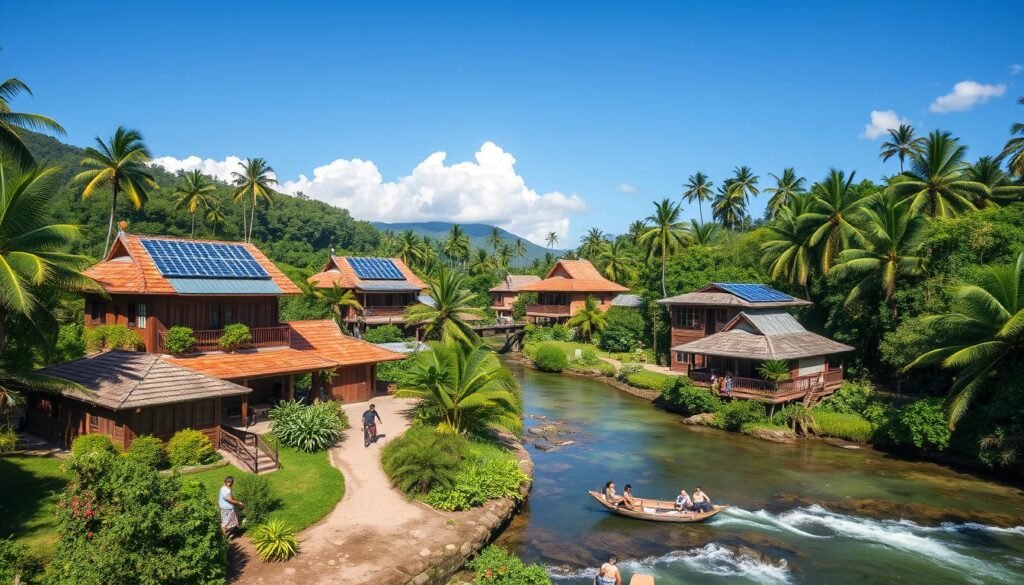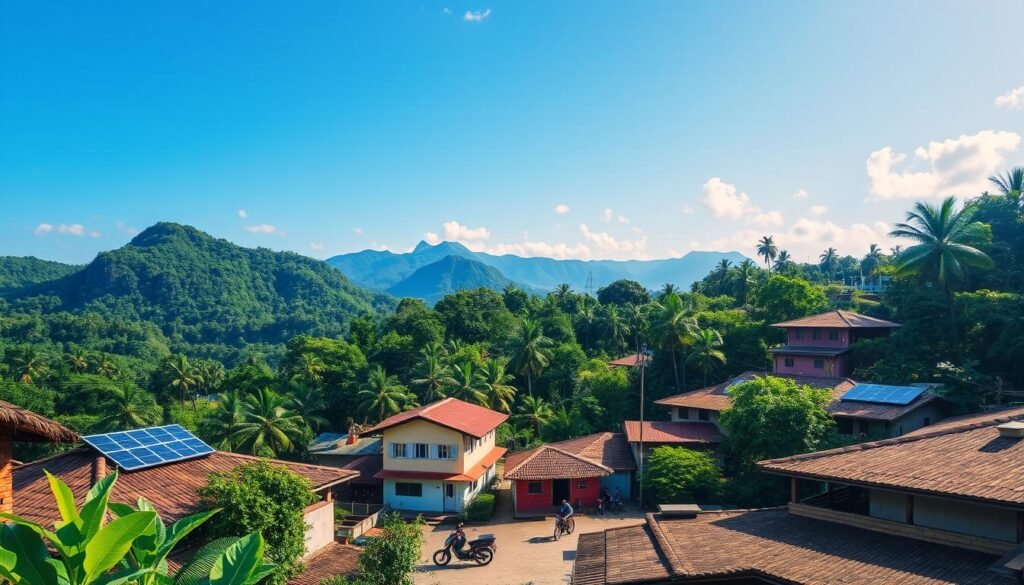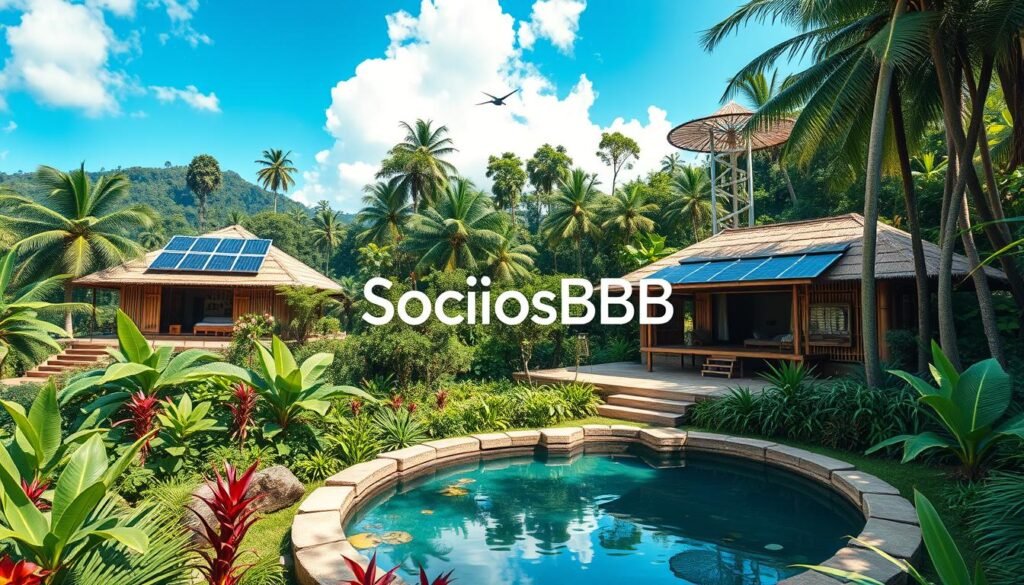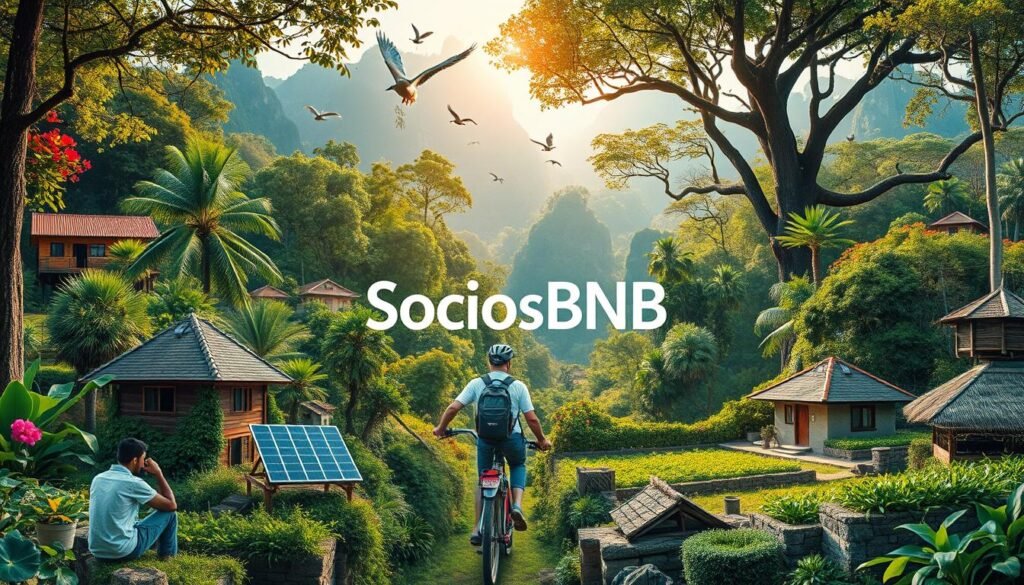Latin America is showing the world how to travel responsibly. It focuses on protecting the environment and helping local communities. From Belize’s rainforests to Colombia’s cities, the region is a leader in eco-friendly tourism.
But what are these sustainable travel initiatives? How are they changing tourism in Latin America? Let’s explore this eco-friendly journey together.
Key Takeaways
- Latin America is at the forefront of sustainable travel initiatives that protect the environment and support local communities.
- Ecotourism, community-based tourism, and conservation efforts are thriving in destinations like Belize, Costa Rica, Colombia, and Ecuador.
- Female entrepreneurship programs and Indigenous tourism experiences are empowering marginalized communities in the region.
- Sustainable accommodations and eco-lodges are leading the way in demonstrating the feasibility of greener tourism practices.
- Challenges remain in addressing environmental concerns and preserving cultural heritage, but the region is making significant progress.
Introduction to Sustainable Travel in Latin America
Latin America is leading the way in regenerative travel. This movement focuses on making ecosystems and local communities healthier. Despite progress in sustainable tourism, old travel ways have harmed the environment and culture.
The Importance of Regenerative Travel
The move to sustainable travel in Latin America aims to protect nature and culture. It helps local communities and reduces tourism’s harm. This approach helps restore and grow the environment and society.
The Impact of Traditional Tourism on Latin America
Old tourism ways have hurt Latin America’s environment and culture. They’ve reduced natural resources, harmed wildlife, polluted, and eroded culture. Now, there’s a push for sustainable and regenerative travel to fix these problems.
| Sustainable Travel Initiatives in Latin America | Key Impacts |
|---|---|
| Expansion of national parks and protected areas | Preserving natural habitats and biodiversity |
| Promotion of community-based tourism | Empowering local communities and supporting their economic development |
| Adoption of eco-friendly practices by tourism businesses | Reducing environmental footprint and promoting sustainable operations |
| Traveler education and awareness campaigns | Encouraging responsible and mindful travel behaviors |
Latin America’s varied landscapes offer chances for sustainable travel. This travel respects the area’s natural and cultural treasures. By choosing regenerative travel, the tourism industry can create a better future.
Ecotourism Hotspots in Latin America
Latin America is a top spot for ecotourism. It has many natural wonders and diverse ecosystems. Belize and Costa Rica are leading the way in sustainable tourism.
Belize: Community-Based Tourism and Conservation Efforts
In Belize, tourism focuses on empowering local communities. It also protects the country’s biodiversity. The Garifuna Cultural Trail and the Living Maya Experience let visitors dive into local cultures and traditions.
These experiences support conservation and give economic benefits to communities. They help preserve Belize’s cultural heritage and offer jobs.
Costa Rica: Leading the Way in Sustainable Tourism
Costa Rica is a pioneer in sustainable tourism. It has invested in eco-friendly tourism facilities. This promotes practices that protect the environment.
Costa Rica’s efforts are showing results. The scarlet macaw population is growing, showing healthy ecosystems. It’s a model for other countries in Latin America.
“Sustainable tourism in Latin America is not just a buzzword, but a way of life. Destinations like Belize and Costa Rica are paving the way for a future where travel can coexist in harmony with nature and local communities.”
Empowering Local Communities Through Tourism
Sustainable tourism in Latin America is more than just protecting nature. It’s also about empowering local communities. By getting residents involved in planning and management, supporting local businesses, and creating jobs, tourism helps improve livelihoods and community development across the region.
The Panama Sustainable Tourism Model is a great example. It works with 10 pilot communities to help indigenous, Afro, and mestizo peoples protect their ecosystems and cultural heritage. The model also created a network of trails called the ‘1000 km of Trails’ project to involve local communities in tourism.
Sumak Travel is another success story. This tour operator focuses on community-based tourism experiences in Latin America. Sumak Travel works with just one local tour operator per country to ensure quality and align with their mission of offering unique experiences.
But, commercializing community-based tourism in Latin America comes with challenges. There’s a need to change the negative image of low quality and discomfort. There’s also a need to manage customer expectations and help with marketing skills in projects led by non-governmental organizations.
“Sumak Travel advocates rephrasing community-based tourism as local, authentic, cultural, or remote tourism to improve client understanding and acceptance of these travel experiences.”
By empowering local communities and supporting sustainable livelihoods, these tourism initiatives do more than protect the environment. They also promote community empowerment and local economic development across Latin America.
| Sustainable Tourism Initiatives | Impact |
|---|---|
| Panama Sustainable Tourism Model |
|
| Sumak Travel |
|
Sustainable Travel Initiatives in Central America
In the heart of Central America, Panama is leading the charge in sustainable travel. The SOSTUR network connects travelers with real rural and community-based tourism. It helps small and Indigenous communities and focuses on conservation.
Panama’s SOSTUR network shows how sustainable travel can help local communities and protect nature. It offers immersive experiences that let travelers see the local culture and traditions. This approach meets the growing need for meaningful travel.
“66% of global respondents have shown interest in having a positive impact on the environment through their daily actions.”
As the world recovers from the pandemic, sustainable travel is more important than ever. Inbound spending won’t reach pre-crisis levels until 2026. Panama and other Central American countries can lead by offering sustainable experiences.

Central America has many sustainable travel initiatives. Costa Rica leads in eco-tourism, and Belize focuses on community-based conservation. These efforts show the region’s commitment to responsible travel. As more travelers seek these experiences, Central America’s future in sustainable travel looks bright.
Sustainable Travel Initiatives in South America
South America is leading the way in sustainable travel. It’s empowering local communities and protecting the region’s culture and environment. Programs like Colombia’s Tú Mujer and Ecuador’s community tourism are changing the game. They’re making tourism more inclusive and beneficial for everyone.
Colombia: Tú Mujer Program Supporting Female Entrepreneurs
In Colombia, the Tú Mujer program is breaking down gender barriers. It’s training over 10,000 women in tourism. This is creating jobs and making tourism more diverse.
These women are using their skills to offer unique travel experiences. They’re showing off Colombia’s rich culture in a sustainable way.
Ecuador: Promoting Community Tourism and Indigenous Experiences
In Ecuador, the Multinational Federation of Community Tourism is offering new experiences. These let travelers dive into the country’s communities. They include experiences with Ecuador’s 14 Indigenous peoples.
Places like the Sinchi Warmi lodge are preserving traditions. They’re also giving local communities a chance to thrive. This helps the whole region.
| Sustainable Travel Initiatives in South America | Key Highlights |
|---|---|
| Tú Mujer Program in Colombia |
|
| Community Tourism in Ecuador |
|
Colombia and Ecuador are showing the power of sustainable travel. They’re empowering communities, protecting culture, and caring for the environment. These efforts are making tourism better for everyone involved.
sustainable travel initiatives in latin america
In Latin America, the tourism industry is changing for the better. It’s not just about being green; it’s about making places better. Travelers are helping by supporting local farms and joining in on community projects. This helps keep the area’s nature and culture safe for future visitors.
The Green Initiative is a big step towards a greener future. It’s part of a challenge to find new ways to cut down on pollution. The goal is to make tourism better for the planet and for local communities.
There are many groups working together to make travel better. The Yuluca Alliance is one example. It was started after a big meeting in Colombia. It wants to help keep places beautiful and involve locals in tourism.
Latin America is full of protected areas, showing its love for nature. The Galapagos Marine Reserve got bigger to fight overfishing. Peru is seen as the greenest place to visit in the region.
Traveling responsibly in Latin America helps everyone. It supports local businesses and protects the environment. By choosing eco-friendly options, travelers can make a big difference.

“Sustainable travel contributes to the development of the Latin American economy while preserving natural resources and biodiversity.”
Brazil: Combating Deforestation Through Community Tourism
In the heart of the Amazon, community-based tourism is key in fighting deforestation. Places like Pousada do Garrido and Vivalá help local Indigenous communities. They offer jobs and teach visitors about saving the Amazon’s nature and traditions.
Vivalá: Connecting Travelers with Indigenous Communities
Vivalá is a leader in ecotourism, linking travelers with Brazil’s Indigenous communities. It offers deep experiences that show off the culture and green ways of these groups. This helps support their lives and protects the Amazon rainforest.
“Through our partnerships with Indigenous communities, we’re able to offer unique experiences that go beyond the typical tourist offerings. Visitors can engage in traditional activities, learn about medicinal plants, and witness the deep connection between these communities and the land they call home.” – Vivalá representative
Vivalá and others focus on community tourism brazil. They help save the Amazon’s indigenous tourism brazil and fight deforestation amazon. These efforts give local communities a chance to care for their land and resources.
Community tourism in Brazil shows how travel can help the planet and people. It’s a powerful way to make a difference in saving the environment and improving lives.
Sustainable Accommodations and Eco-Lodges
The demand for green travel in Latin America is growing fast. This has led to more eco-friendly places to stay. These spots help protect nature and support local people. They let visitors enjoy the area’s beauty while being kind to the planet.
Latin America is full of sustainable accommodations and eco-lodges. Places like Costa Rica’s rainforests and Chile’s deserts have them. They use green designs, clean energy, and save water to lessen their harm.
- Nayara Resorts in Costa Rica are now carbon neutral. They also avoid single-use plastics and focus on reducing waste.
- In Chile, Nayara Alto Atacama follows strict rules to cut down waste. It also saves energy and water, using plants to clean and reuse water.
- Pikaia Lodge in the Galapagos Islands, Ecuador, is all about eco-friendly stays. It supports local wildlife and tourism.
These green places offer unique travel experiences. They also help local communities by supporting their economies and protecting their lands. As more people look for sustainable accommodations latin america, eco-lodges latin america, and green hotels latin america, the region is stepping up. It’s showing the world how to travel responsibly.

“Sustainable tourism is not just a trend – it’s a necessity for the future of our planet. Latin America is leading the way in this movement, and I’m thrilled to see the growth of eco-friendly accommodations that allow travelers to explore the region while minimizing their environmental impact.”
Challenges and Future of Sustainable Tourism in Latin America
The tourism industry in Latin America is growing fast. But, the region faces big challenges and opportunities in keeping tourism sustainable. Progress has been made in ecotourism and helping local communities. Yet, worries about harming the environment and preserving culture are still big issues.
Addressing Environmental Concerns
The fast growth of tourism has caused many environmental problems. These include deforestation, pollution, and using up natural resources. Sustainable tourism efforts are key to fix these problems and keep tourism alive for the future.
Preserving Cultural Heritage
Protecting Latin America’s rich culture is crucial for sustainable tourism’s future. Including local traditions in tourism can help keep culture alive. It also gives jobs to local people.
| Challenges | Opportunities |
|---|---|
| Environmental concerns (deforestation, pollution, resource depletion) | Increased investment in ecotourism and regenerative travel |
| Cultural erosion and loss of traditional practices | Empowering local communities in tourism planning and management |
| Balancing economic growth with sustainability | Promoting sustainable tourism as a driver for regional development |
The future of sustainable tourism in Latin America depends on three things. It needs to protect the environment, save cultural heritage, and support local communities. By tackling these challenges and using the region’s natural and cultural riches, tourism can help make Latin America a better place.
Conclusion
Latin America is leading the way in sustainable travel, changing the tourism game. It’s creating experiences that are good for the planet and for local people. This approach makes travel meaningful and fun, while helping the environment.
By protecting nature and supporting local communities, Latin America is a top player in sustainable tourism. It lets visitors see its beauty and help make the future greener.
The region is full of new ideas for green travel. From Belize’s community projects to Ecuador’s laws for nature, it’s showing the world how it’s done. Latin America is making tourism better by focusing on nature, local food, and indigenous cultures.
This shift is making tourism in Latin America exciting and responsible. It invites people to learn about and respect its cultures and landscapes.
The tourism world is getting bigger, with 1.3 billion visitors in 2017. Latin America’s future in green travel looks bright. With everyone working together, it can stay a top choice for those who want to travel responsibly.
Visitors will get to see amazing sights and help protect them. This is a win-win for everyone, making travel a positive experience for both the planet and its people.
FAQ
What are some of the sustainable travel initiatives in Latin America?
Latin America is at the forefront of sustainable travel. It includes community-based tourism, environmental conservation, and support for female entrepreneurs. These efforts are seen in places like Belize, Costa Rica, Colombia, Ecuador, Panama, and Brazil.
How are Belize and Costa Rica promoting sustainable tourism?
Belize focuses on community-based tourism to benefit local communities and protect biodiversity. Costa Rica is investing in green tourism infrastructure. It also sees an increase in scarlet macaws, showing healthy ecosystems.
How are local communities being empowered through sustainable tourism in Latin America?
Sustainable tourism empowers local communities in Latin America. It involves residents in planning and supports local businesses. This creates jobs and improves livelihoods across the region.
What sustainable travel initiatives are happening in Central America and South America?
In Panama, the SOSTUR network connects travelers with community-based tourism. Colombia’s Tú Mujer program trains female entrepreneurs in tourism. Ecuador’s Multinational Federation of Community Tourism offers experiences with Indigenous peoples.
How are community tourism initiatives in Brazil helping to combat deforestation in the Amazon?
In Brazil, community tourism projects like Pousada do Garrido and Vivalá offer income to Indigenous communities. This empowers locals and engages visitors in preserving the Amazon’s biodiversity and traditions.
What types of sustainable accommodations are available in Latin America?
Latin America is seeing more eco-friendly accommodations and eco-lodges. These prioritize environmental conservation and support local communities. They allow visitors to enjoy nature while reducing their impact.
What are some of the challenges and future considerations for sustainable tourism in Latin America?
Latin America faces challenges like deforestation and pollution in sustainable tourism. It also needs to protect cultural heritage. As tourism grows, integrating sustainable practices is key to protecting the environment and empowering communities.



